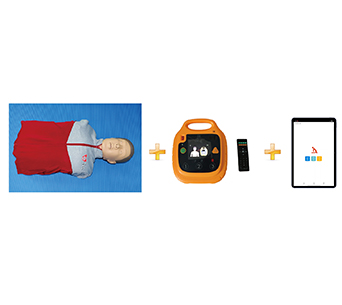■ The upper torso simulator of an adult male is made of polymer material, which is environmentally friendly and pollution-free; The anatomical landmarks are obvious and can touch the nipples, ribs, sternum, and xiphoid process, making it easy to operate and locate.. It has a locking port for the lung bag, which can be used to lock the position of the lung bag and prevent the overall movement of the lung bag. The thickness of the chest skin should not be less than 4mm, with a realistic feel.
■ Simulate the accurate anatomical position of the human head and neck, with the head able to swing left and right and rotate horizontally 180 degrees, making it easy to remove oral foreign objects.
■ The eyeball adopts OLED simulation, with visible colored retina, black pupils, transparent crystals, and the ability to reflect light at any angle; The pupil has a reflex to light, which automatically changes with the condition. In a dead state, the pupil dilates and the reflex to light disappears.
■ The carotid artery pulsation can be palpable, and in a state of death, the carotid artery pulsation disappears; The intensity of carotid artery pulsation has force feedback, and the greater the pressure on the finger, the stronger the pulse beating, which can be perceived as whether there is a checked pulse.
■ The head is equipped with sensors, and the open airway can automatically provide feedback; Internally installed sensors can sense tapping and calling, and tapping calls can automatically provide feedback.
■ The first aid chain has multiple automatic reactions throughout the entire process, including tapping, assessing carotid artery awareness, opening the airway, gas entering the stomach, CPR, and other indicators.
■ Imulate AED
■ The simulator is a highly simulated AED with an appearance that is indistinguishable from the real AED, and the operation process is the same as the real AED operation, making it easy to train emergency personnel for AED training.
■ Designed in full accordance with the latest guidelines of the American Heart Association (AHA), with 10 scenario modes recommended by the AHA for training use.
■ It can cooperate with simulated human demonstrations to intelligently detect whether electrode plates are inserted.
■ Adult or child defibrillation modes can be selected, equipped with two types of electrodes for children and adults, making teaching easier.
■ Simulate AED with a color screen on the front for animated demonstrations of first aid.

■ Wireless connection is used between the simulated AED and the simulator, which can be configured and connected by scanning QR codes on the mobile end. Multiple sets of products can be used simultaneously without interference from the venue and quantity.
■ The system can train and assess CPR and AED separately, automatically detecting whether the electrode is connected. When the defibrillation is correct, the control end receives the defibrillation energy value and records the number of defibrillations, generating a transcript.
■ Simulated humans can scan QR codes on their mobile phones or tablets, or manually connect to WiFi for connection. There are three operating modes: practice, assessment, and practical mode.
■ The transcript can be saved, exported and printed, or connected to a WIFI printer for printing.
1■ Real time recording of data, and recording the pressing and blowing process in the form of curves, makes the statistical results more intuitive and can record the details of each operation.
■ The pressing frequency is calculated for each press and recorded in the form of a curve drawn from a point. This method can objectively record the range of pressing frequencies to ensure the judgment of whether each press is within the standard frequency range.
■ Full course electrocardiogram display:
* Before rescue: An electrocardiogram showing imminent death, disappearance of respiratory chart, and blood pressure below 60mmHg.
* During rescue: During the compression operation, display the compression .electrocardiogram with a frequency consistent with the compression frequency, and the respiratory monitoring displays the tidal operation graph.
* After successful rescue: it shows sinus rhythm and breathing returns to normal.









